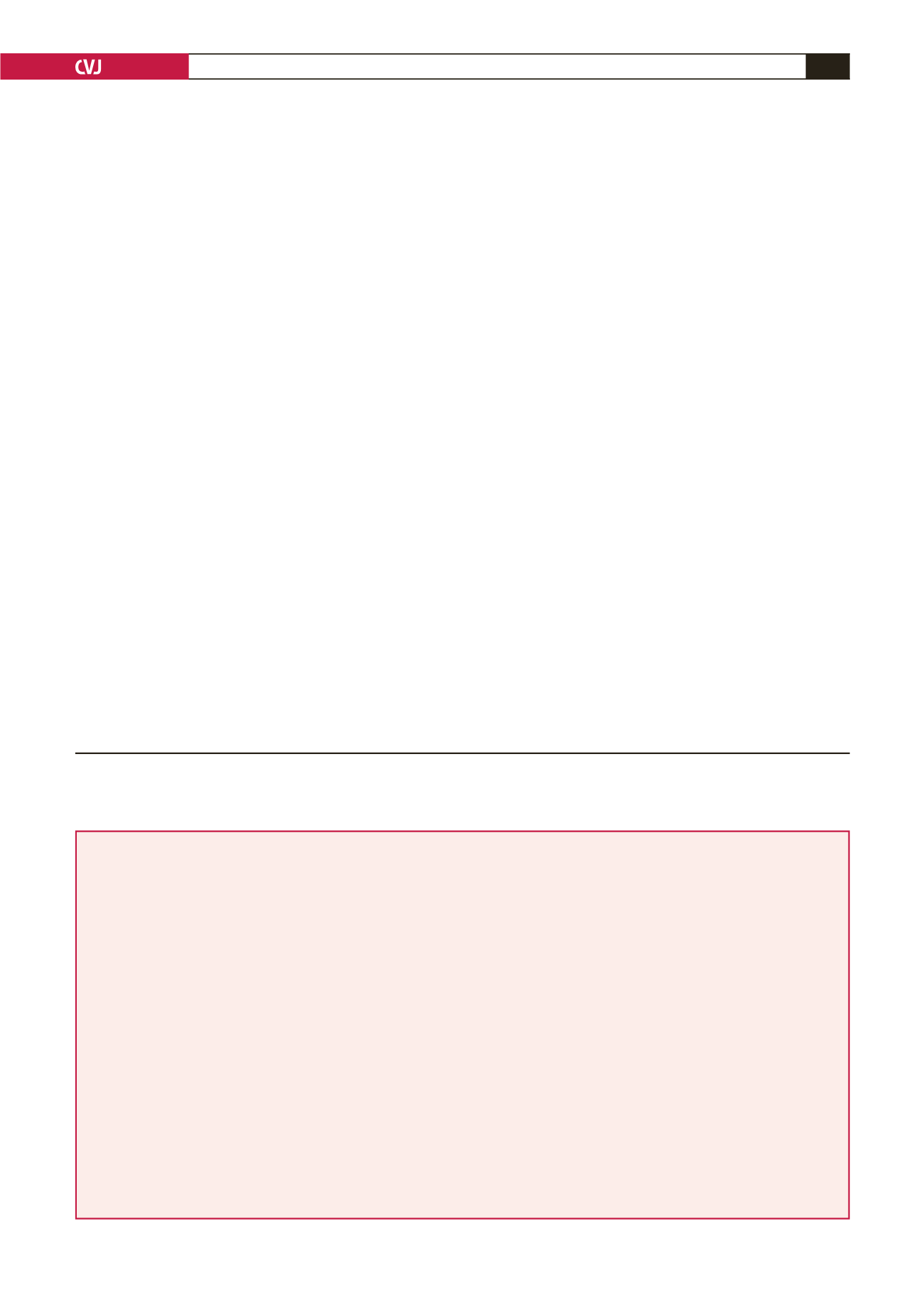

CARDIOVASCULAR JOURNAL OF AFRICA • Volume 27, No 4, July/August 2016
AFRICA
221
to Prevent Heart Attack Trial (ALLHAT).
J Am Med Assoc
2002;
288
:
2981–2997.
4.
Antman E, Hand M, Armstrong W, Armstrong. P, Bates E, Green
L,
et al.
2007 focused update of the ACC/AHA 2004 guidelines for
the management of patients with ST-elevation myocardial infarction:
a report of the American College of Cardiology/American Heart
Association Task Force on practice guidelines.
Circulation
2008;
117
:
296–329.
5.
Brahmajee K, Elizabeth H, Harlan K. Time to treatment in primary
percutaneous coronary intervention.
N Engl J Med
2007;
357
: 1631–
1638.
6.
Goodman S, Cohen M, Bigonzi F, Gurfinkel E, Radley D, Le Iouer V,
et al
. A comparison of low molecular weight heparin with unfraction-
ated heparin for unstable coronary artery disease.
N Eng J Med
1997;
337
: 447–452.
7.
Ferguson J, Calif R, Antman E, SYNERGY Trial Investigators.
Enoxaparin versus unfractionated heparin in high risk patients with
non-ST-segment elevation acute coronary syndromes managed with
an intended early invasive strategy: Primary results of the SYNERGY
randomized trial.
J Am Med Assoc
2004;
292
: 45–54.
8.
Sabatine M, Cannon C, Gibson M, López-Sendón JL, Montalescot
G, Theroux P,
et al
. Addition of clopidogrel to aspirin and fibrinolytic
therapy for myocardial infarction with ST-segment elevation.
N Eng J
Med
2005;
352
: 1179–1189.
9.
Werf F, Bax J, Betriu A, Blomstrom-Lundqvist C, Crea F, Falk V,
et
al.
Management of acute myocardial infarction in patients presenting
with persistent ST-segment elevation.
Eur Heart J
2005;
29
: 2909–2945.
10. Bassand P, Hamm C, Ardissino D, Task Force for the management
of acute coronary syndromes (ACS) in patients presenting without
persistent ST-segment elevation of the European Society of Cardiology
(ESC). Guidelines for the diagnosis and treatment of non ST-segment
elevated acute coronary syndromes.
Eur Heart J
2007;
31
: 1462–1536.
11. Cannon C, Braunwald E, McCabe C, Rader DJ, Rouleau JL, Belder
R,
et al
. Intensive versus moderate lipid lowering with statins after acute
coronary syndromes.
N Eng J Med
2004;
350
: 1495–1504.
12. Kim A, Michael J, Omar H. A validated prediction model for all forms
of acute coronary syndrome: estimating the risk of 6-month post-
discharge death in an international registry.
J Am Med Assoc
2004;
291
:
2727–2733.
13. Granger B, Goldberg J, Dabbous O, Pieper KS, Eagle KA, Cannon CP,
et al.
Predictors of hospital mortality in the Global Registry of Acute
Coronary Events.
Arch Inter Med
2003;
163
: 2345.
14. Babaev A, Frederick P, Pasta D, Every N, Sichrovsky T, Hochman JS.
Trends in management and outcomes of patients with acute myocardial
infarction complicated by cardiogenic shock.
J Am Med Assoc
2005;
294
: 448–454.
15. O’Connor G, Quinton HB, Traven ND, Ramunno LD, Dodds
TA, Marciniak TA, Wennberg JE.
G
eographic variation in the treatment
of acute myocardial infarction: the Cooperative Cardiovascular Project
.
J Am Med Assoc
1999;
281
: 627–633.
16. Bassand P, Hamm CW, Ardissino D, Boersma E, Budaj A, Fernández-
Avilés F,
et al.
Guidelines for the diagnosis and treatment of non
ST-segment elevated acute coronary syndromes.
Eur Heart J
2007;
28
:
15.
17. Thygesen K, Alpert J, White H, on behalf of the Joint ESC/ACCF/
AHA/WHF task force for the redefinition of myocardial infarction.
Universal definition of myocardial infarction.
Eur Heart J
2007;
28
:
2525–2538.
18. Steyn K, Sliwa K, Hawken S, Commerford P, Onen C; INTERHEART
Investigators in Africa. Risk factors associated with myocardial infarc-
tion in Africa the INTERHEART Africa study.
Circulation
2005;
112
:
3554–3561.
During prolonged low-intensity exercise, caffeine alters blood
glucose levels
The effects of caffeine versus maltodextrin during exercise were
observed in patients with type 2 diabetes. Researchers examined
the effects on blood pressure (BP), heart rate (HR) and blood
glucose (BG) levels associated with the intake of caffeine in
comparison to maltodextrin (CHO) during prolonged periods
of low-intensity exercise in patients with type 2 diabetes.
Researchers conducted a pilot study on eight individuals with
type 2 diabetes who were aged 55
±
10 years. The participants
either received 1 g/kg of CHO or 1.5 mg/kg of caffeine
before undergoing exercise. They then exercised for 40 minutes,
executed at 40% HR reserve, and recovered for 10 minutes.
Their BP and exertion, assessed by the Borg scale, were
checked every two minute, and their BG levels were checked
every 10 minutes. The ANOVA test was used for statistical
analysis, and a
p
-value
<
0.05 indicated statistically significant
results.
Neither of the treatments produced significant changes
in BP and HR. However, 1.5 mg/kg caffeine significantly
reduced BG levels by 75 mg/dl (65% CI;
p
<
0.05) as opposed
to 1 g/kg maltodextrin, which produced no significant change
in BG levels during the 40-minute period of exercise.
References
1.
Da Silva LA, De Freitas L, Medeiros TE, Osiecki R, Garcia Michel
R, Snak AL,
et al
. Caffeine modifies blood glucose availability
during prolonged low-intensity exercise in individuals with type-2
diabetes.
Colomb Med (Cali)
; 2014;
45
(2):72-76. eCollection 2014
Apr. PubMed PMID: 25100892.
2.
http://www.diabetesincontrol.com/index.php?option=com_content&view=article&id=16750&catid=1&Itemid=17.

















